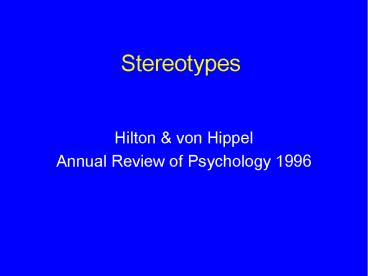Stereotypes - PowerPoint PPT Presentation
Title:
Stereotypes
Description:
Stereotypes Hilton & von Hippel Annual Review of Psychology 1996 Key Question: Is Prejudice Inevitable by-product of miserly cognitive style vs. Product of deep ... – PowerPoint PPT presentation
Number of Views:145
Avg rating:3.0/5.0
Title: Stereotypes
1
Stereotypes
- Hilton von Hippel
- Annual Review of Psychology 1996
2
Key Question Is Prejudice
- Inevitable by-product of miserly cognitive style
- vs.
- Product of deep-seated personality motivational
factors
3
Answer
- Affect and motivation often increases reliance on
cognitive stereotyping processes - Also may inhibit or decrease stereotyping
processes
4
Heuristics
- Humans cant process all info available, in
thoroughly scientific, unbiased manner - Brain/Mind has evolved info-processing rules,
algorithms, short-cuts - Select a little info evaluate it quickly
- ? cognitive miser
5
Definitions
- Beliefs about the characteristics, attributes,
and behaviors or members of certain groups. - ? Sometimes accurate representations of reality
- ? Sometimes formed independent of real
differences
6
Focus of Review
- Stereotypes arising from miserly cognitive
style - But maintained when no evidence of
corresponding group characteristics
7
Organization of Review
- How are stereotypes represented in mind/brain
- How formed?
- How maintained?
- How applied?
- How changed?
8
Representation of Stereotpyes
- Prototype groups typical features
- Exemplar prototype is specific individual
- Associative network linked attributes
- Schemas general, abstract beliefs
- Base rates average expectable behavior
9
Queston
- What of the exaggerated caricatures of we saw
in Ethnic Notions? - Flawed information processing?
- or
- Evidence of emotion motivation?
10
Formation
- Self-fulfilling prophecies (C. Word)
- Non-conscious detection of covariation
- (a few stereotype-congruent examples ?
self-perpetuating) - Illusory correlation
- (more processing devoted to negative info about
minorities same correlation not noted or not
remembered among in-group members)
11
Formation (cont)
- Out-group homogenaiety
- heuristic of info-processing see out-group
members as similar - H. Tajfels minimal group experiments
12
Maintenance
- Info-processing heuristics
- Priming
- Assimilation
- Attribution processes
- Memory processes
13
Maintenance
- Priming effects
- Making category or trait salient, so people
perceive think in terms of it - Usually outside of conscious awareness
14
Maintenance
- Assimilation
- Individual automatically perceived as
resembling group stereotype
15
Maintenance
- Attributional processes
- ? Fundamental attribution error
- (overestimate others personal dispositions)
- ? Ultimate attribution error
- (dispositional attributions for positive in-
- group and negative out-group actions)
16
Maintenance
- Memory Processes
- Better memory for stereotype-incongruent
information ? works against stereotyping - But incongruent info ? dissonance ?
diss.-reducing defense of stereotype - Also high demand ? better memory for
stereotype-congruent info.
17
Application
- Automaticity stereotype activation becomes
automatic at young age - Suppression takes effort
- Threats to self-esteem activate
- Ambiguity ambiguous situations ? greater
reliance on stereotypes - (Gaertner Dovidio)
18
Prejudice as application of stereotypes
- Aversive racism egalitarian values but negative
affect - Modern / symbolic / subtle racism
negative affect rationalized by non-racist issues - Ambivalent racism egalitarian Protestant
ethic values ? quick to praise to condemn
19
Prejudice
Style of information processing that uses
stereotypes for repre-senting out-groups
20
Stereotype Change
- Bookkeeping model incremental updates
- Conversion model dramatic change
- Subtyping model inconsistent info given new
sub-category - Exemplar model change prototype
21
Inhibition of Stereotypes
- Suppression likely to prime stereotypic
perception and processing - Personal commitment to not stereotype makes
suppression more successful
22
Conclusions
- Know more about development of stereotypes than
how to reduce their use - Dont understand non-conscious aspects of
stereotyping
23
Questions
- What is the causal role played by cognitive
heuristics by natural biases in
information-processing? - How do we integrate cognitive factors with
emotional, motivational, and societal to explain
prejudice? - Do cognitive heuristics doom us to prejudice?































